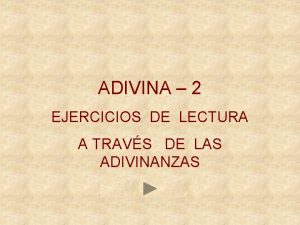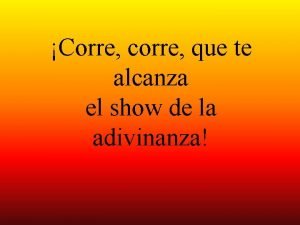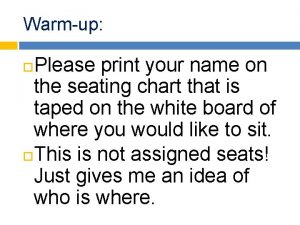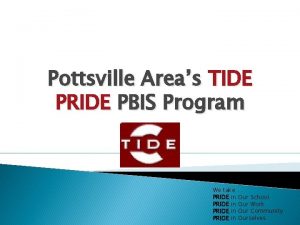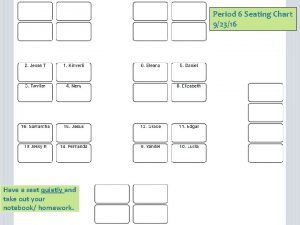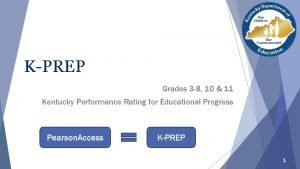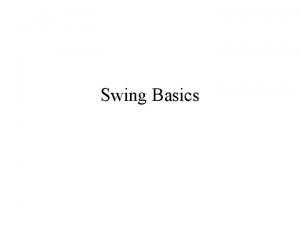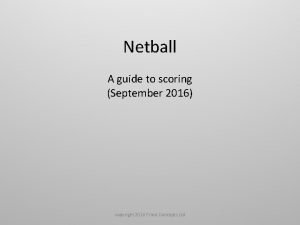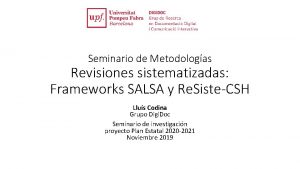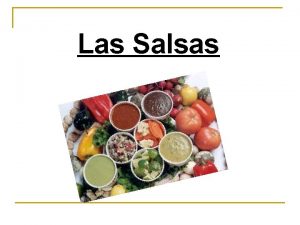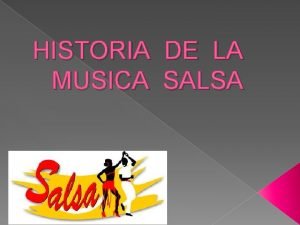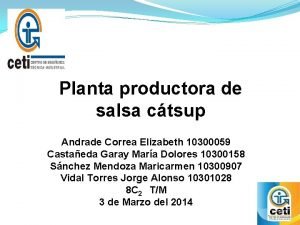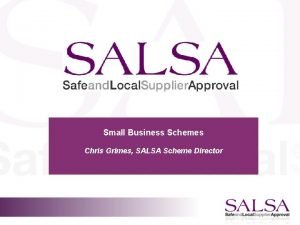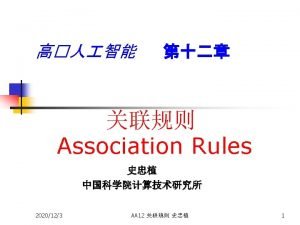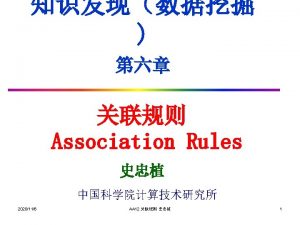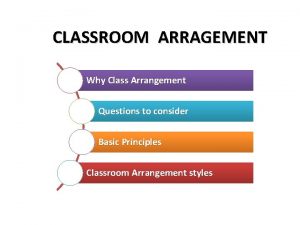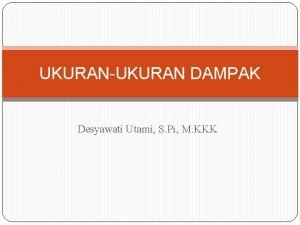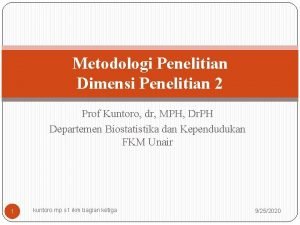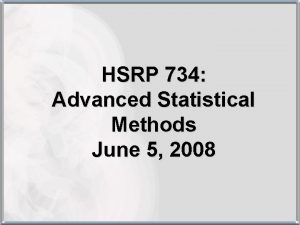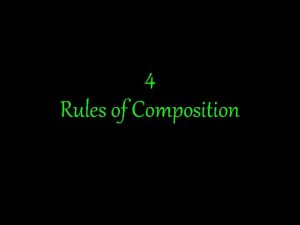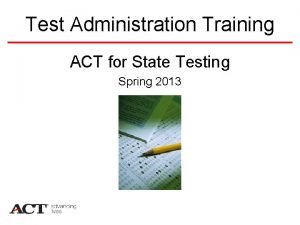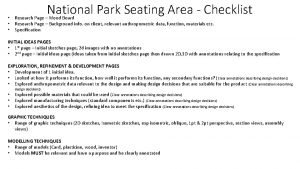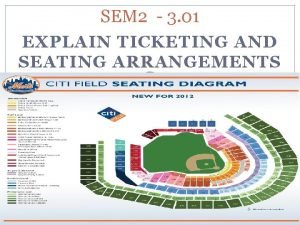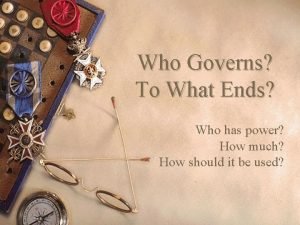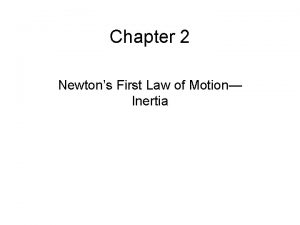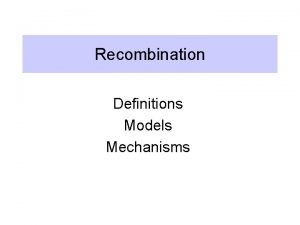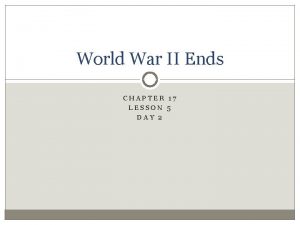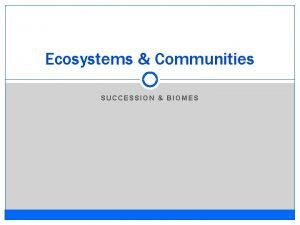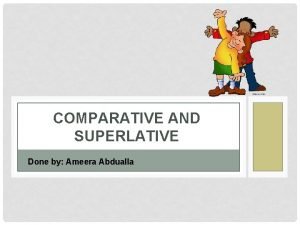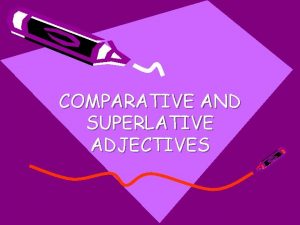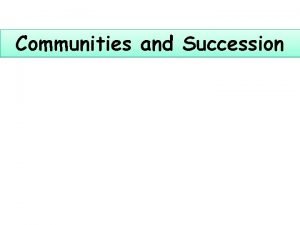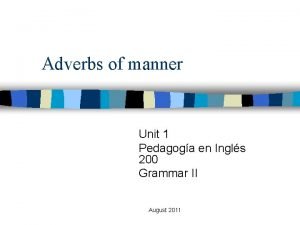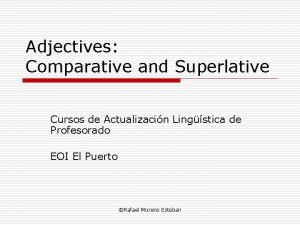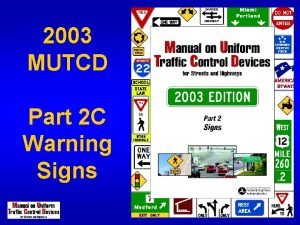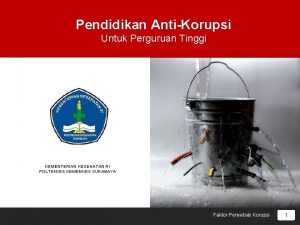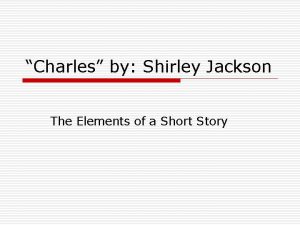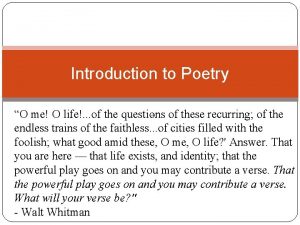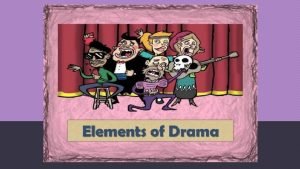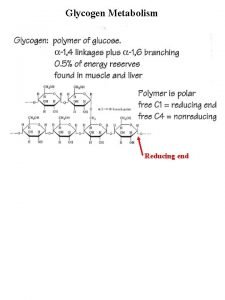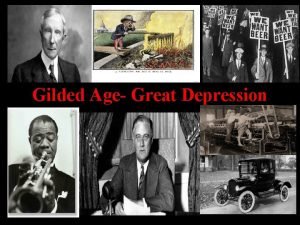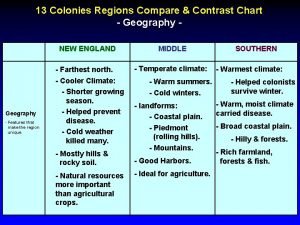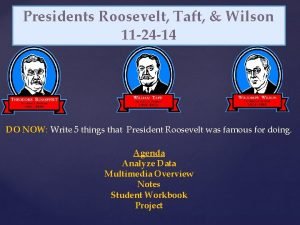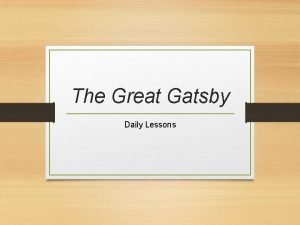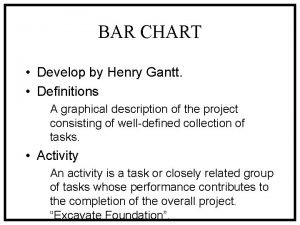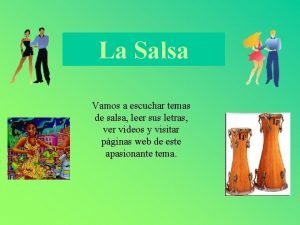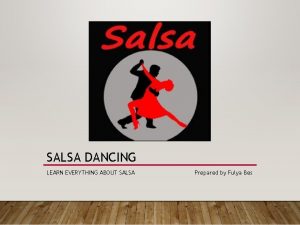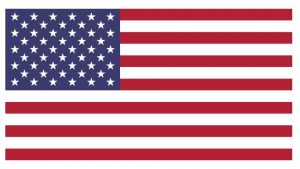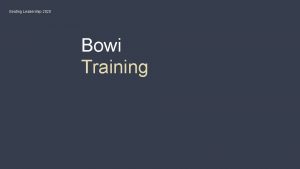Odds and Ends New seating chart Salsa Verde














































































































































- Slides: 142


Odds and Ends New seating chart Salsa Verde Cooperative Skill of the Week Homework

Learning Targets Content Targets: I will predict distances traveled by slaves on slave ships I will record goods traded across the Atlantic Ocean I will read about the Middle Passage I will interpret artwork with regard to slavery Language Targets: I will explain thoughts/feelings about slaves and slave ships

ISN: Essential Questions: Was the Slave Trade more a function of a misunderstood perception of superiority of one people over another, or one of economics – money making? What are the long-term effects of traumatic events?

Final Assessment - Homework Slave Narrative – Writing a story from the perspective of a slave Must be told in the first person What is empathy? The ability to understand share the feelings of another You will get checklists for each section as we complete them

How far is…? How long does it take to get there? Discuss in your team – write down responses From here to downtown? To Boulder? To the border of Mexico? To Los Angeles? To New York?

How far are places? From here to downtown? 5 Miles To Boulder? 23 Miles To the border of Mexico? 720 Miles To Los Angeles? 1000 Miles To New York? 1800 Miles

World Map Draw a rough outline in your notebook of landmasses on either side of the Atlantic Ocean Label Continents and countries Label Bristol, England; Charleston, South Carolina; and, Cote d'Ivoire (Ivory Coast), Africa Connect each city with a line

Distances How far did the ships travel from England to the Ivory Coast? How far did the Africans travel from the Ivory Coast to Charleston? How far did the trips have to travel to return to England?

World Map

Distances How far did the ships travel from England to the Ivory Coast? [Bristol, England to Ivory Coast – 2, 997 miles/4823 kilometres] How far did the Africans travel from the Ivory Coast to Charleston? [Ivory Coast to Charleston, S. C. – 5, 051 miles/8129 kilometres] How far did the trips have to travel to return to England? [Charleston, S. C. to Bristol, England – 3, 978 miles/6402 kilometres]

Speed Using the approximate average rate of speed of five miles traveled per hour, calculate how long it would take to travel to each place by ship Bristol, England to Ivory Coast = 600 hours/4 weeks Ivory Coast to Charleston, S. C. = 1, 000 hours/6 weeks Charleston, S. C. to Bristol, England = 800 hours/5 weeks Record times on triangle line


Odds and Ends New seating chart Salsa Verde Cooperative Skill of the Week Homework

Learning Targets Content Targets: I will predict distances traveled by slaves on slave ships I will record goods traded across the Atlantic Ocean I will read about the Middle Passage I will interpret artwork with regard to slavery Language Targets: I will explain thoughts/feelings about slaves and slave ships

Review How far was it from Bristol, England to the Ivory Coast? How long did it take to travel the distance by ship? How far was it from the Ivory Coast to South Carolina? How long did it take to travel the distance by ship? How far was it from South Carolina to Bristol, England? How long did it take to travel the distance by ship?

The Middle Passage by Tom Feelings Read on your own Highlight important parts or things that stand out to you Record thoughts and feelings in your notebook What parts of the reading were particularly interesting or moving? Why? Write 5 questions about the reading. Choose 3 pictures to comment about, and write what you think or feel when they look at them

Tom Feelings: The Middle Passage What parts of the reading were particularly interesting or moving? Why?

Tom Feelings: The Middle Passage What were people’s questions about the reading

Tom Feelings: The Middle Passage What pictures did you have comments or questions about?

Tom Feelings: The Middle Passage

Tom Feelings: The Middle Passage

Tom Feelings: The Middle Passage

Tom Feelings: The Middle Passage

Tom Feelings: The Middle Passage

Tom Feelings: The Middle Passage

Tom Feelings: The Middle Passage

Tom Feelings: The Middle Passage

Tom Feelings: The Middle Passage

Other questions for discussion What do you think about what happened to Africans? Did people not think what they were doing was wrong? What do you think it would have been like? Time, chained, Why do you think it happened? Racism? Money? Both?

Door of No Return What do you think this picture is now? This is the last thing an African would have seen before being placed on a slave ship

Summary Explain what you learned about the Middle Passage today



Odds and Ends Salsa Verde Cooperative Skill of the Week Homework due Friday Part 1 – Introduction Part 2 – From Africa to America: The Middle Passage

Today’ Objectives Content: Read primary sources about the experiences of slaves during the Middle Passage Record goods traded across the Atlantic Ocean to understand how different continents demanded different goods Language: Identify and summarize specific information that can/will be used in the Slave Narrative Final Assessment

Essential Questions: Was the Slave Trade more a function of a misunderstood perception of superiority of one people over another, or one of economics – money making? What was it like to travel on a slave ship?

Review What were the conditions on a slave ship according to The Middle Passage by Tom Feelings?

Draw map in your notebook and label

ISN: Write the goods traded from each continent

What words would you use to describe Africa today? How did Africa become that way? How can the Triangle Trade System tell us?

ISN: The Middle Passage - Primary Sources What is the Middle Passage? Read the Primary Sources about the Middle Passage What details are given for what it was like to travel on a slave ship? List in notes

Speculum Oris The Middle Passage - Primary Sources

What does this picture tell us?

Homework 1: Part 1 and 2 of Slave Story Go over checklist 1 Start planning and drafting Part 1 and 2 of you narrative


Odds and Ends Salsa Verde Cooperative Skill of the Week Homework

Learning Targets Content Targets: I will read a fictional account of a slave auction to better understand conditions in slavery I will identify experiences of slaves Language Targets: I will discuss the experiences of slaves

The Slave Auction Uncle Tom’s Cabin by Harriet Beecher Stowe This book helped Northerners become more outraged by the horrors of slavery, and pushed the country closer to Civil War When Harriet Beecher Stowe met Abraham Lincoln while the Civil War was going on, he commented to her, “So, you’re the little lady that started all this trouble. ”

The Slave Auction Uncle Tom’s Cabin by Harriet Beecher Stowe Number Paragraphs (1 -95) During the Reading: Circle words not sure of Underline important details of the Auction House Keep in mind you will write a detailed scene in your narrative

Summary What details of a slave warehouse can you use in your narrative?



Odds and Ends Salsa Verde Cooperative Skill of the Week Part 3: Slave Auction due Friday

Learning Targets Content Targets: I will read a fictional account of a slave auction to better understand conditions in slavery I will examine advertisements for slave auctions Language Targets: I will discuss the experiences of slaves

The Slave Auction Uncle Tom’s Cabin by Harriet Beecher Stowe Questions for discussion: Why did the auctioneer want Emmeline to have her hair curled? Why did her mother not want her to? What happened to Tom and Emmeline before they were auctioned when they were lined up waiting? What happened to Emmeline and her mother at the auction?

The Slave Auction Uncle Tom’s Cabin by Harriet Beecher Stowe Questions for discussion: What happened to Emmeline and her mother at the auction? Was that typical? How do you know? What do you think will happen to Emmeline and Tom? What will their experiences as slaves be like with their new owner? What happens to Tom when he is on the boat? Why do you think this happens?

The Slave Auction Uncle Tom’s Cabin by Harriet Beecher Stowe Questions for discussion: What do you think about the two men talking at the end when they say it is the nice slave owners that make it possible for the mean ones to exist? What other ways might people be moved other than boat? Marched…

The Slave Auction: Summary Uncle Tom’s Cabin by Harriet Beecher Stowe After the Reading: Write 2 questions you have about slave auctions Write the 3 worst things you think happened at a slave auction Write a summary paragraph of what you thought and felt hearing the descriptions of the auction house

QUIZ!

QUIZ 2

1. c 2. b 3. c 4. b 5. a 6. d 7. c 8. b QUIZ! - Answers

QUIZ 2 Answers 1. C 2. A 3. B 4. D 5. C 6. Men would buy them for sexual purposes 7. Answers vary 8. Answers vary 9. A quadroon means you are ¼ black and ¾ white


Odds and Ends Salsa Verde Cooperative Skill of the Week Part 3: Slave Auction due Friday

Learning Targets Content Targets: I will read a fictional account of a slave auction to better understand conditions in slavery I will examine advertisements for slave auctions Language Targets: I will discuss the experiences of slaves

Today’s Objectives Content: To consider perspectives and viewpoints of others To analyze a past event Language: To write using proper sentence form and function from a different perspective

Today’s Objectives Content: To use information learned about slaves and slavery in a historical non-fiction writing piece Language: To write/edit a writing piece for content and grammatical usage

Directions If you have parts 1, 2, and 3 done: You will conference with me on the writing and content of your narrative If you do not have parts 1, 2, and 3 done: You will be working silently to finish them


Odds and Ends Salsa Verde Cooperative Skill of the Week Part 3: Slave Auction due Friday

Learning Targets Content Targets: I will define what the cotton gin is as well as its affect on the cotton industry and slaves I will define and discuss aspects the domestic slave market I will examine primary sources about slavery I will identify key aspects of slave life, such as living conditions and religious life, in images, primary sources, and secondary text Language: Explain how economic and social forces contributed to the survival and growth of slavery for nearly 250 years in the United States

ISN: Domestic Slave Trade In 1807, Britain outlaws the African Slave Trade. This severely reduces the amount of slaves taken out of Africa The price for African slaves goes really high What should slave buyers do?

ISN: Domestic Slave Trade Invention of the Cotton Gin – 1793 A device that separated cotton from the seed at least 10 x faster than by hand How would the invention of the cotton gin affect the cotton producing farmers? What would happen to the price of cotton from America? How are slaves affected?

ISN: Domestic Slave Trade Invention of the Cotton Gin – 1793 A device that separated cotton from the seed at least 10 x faster than by hand Dramatically decreased the production time of cotton Cotton is cheaper from American farmers; Plantation owners can grow more cotton than ever before The need for slaves sharply rises

Examine the following ad Write 5 words to describe what you see

Examine the following ad How would you feel if this was your culture and history?

Summary: Domestic Slave Trade When a slave is sold from one plantation to another, what does that mean for the slave and the slave’s family?

ISN: Preview When a slave is sold from one plantation to another, what does that mean for the slave and the slaves family?

Preview 1. What object do you see? 2. What images and symbols does it contain? 3. What story do you think it shows? 4. How do you think the image relates to the Bible and to the experience of slavery?

Preview This square is from a story quilt made in the 1880 s by Harriet Powers, a woman who was enslaved for more than 20 years. Because slaves were given very few clothes and bed coverings, quilts became a necessary and integral part of slave life. Although it is likely that other slaves made story quilts like those of Harriet Powers, none have survived.

Listen to the song Answer Song Analysis Questions

Preview 20 pg. 139 Song Analysis Questions 1. What is the tone of the song? 2. What Bible story is told in the song? 3. How does the song relate to the images in the quilt square? 4. How might the song and the quilt square relate to the experience of slavery?

Quilt Square Song - Moses Stories from the Bible gave African Americans hope despite their miserable conditions, and inspired slaves to fight for their freedom. Several aspects of the biblical story of Moses are referenced in the quilt square and the song. First, the quilt square shows slaves being led out of bondage. Like African Americans, the Jews in the Bible were enslaved for a period of time, and Moses led the Jews out of slavery. In the biblical story, Moses’ staff, which is also depicted in the Harriet Powers quilt, turns into a serpent. Likewise, in the song, slaves used references to the biblical river Jordan to represent escaping bondage and reaching the other side—freedom. Finally, the song’s references to Moses may also have been an allusion to Harriet Tubman, who led many slaves to freedom.




Odds and Ends Salsa Verde Cooperative Skill of the Week Homework for this week – Part 4

Today’s Objectives Content: I will use primary source images of slavery and match them to a reading in the book I will record key aspects of the life of slaves Language: I will research and collect information about slavery for my narrative

Partner Activity Use the images to match to a section in the book Read that section Complete the corresponding notes Use your notebook to collect information for your story What do we need to look for? Part 4 Part 5


Odds and Ends Salsa Verde Cooperative Skill of the Week Homework for this week and next

Today’s Objectives Content: I will use knowledge about slaves I will create a quilt square about one aspect of slave life Language: I will use aspects of slave life and culture to write a narrative about the life of a slave

Part 5: Slave Resistance In what ways did slaves resist their slavery

Part 6: Conclusion

Quilt Block Squares 1. Why were quilts important to slaves? 2. How did they become part of their culture? How does anything become a part of a culture?

How would you describe the design of this quilt spare?

Quilt Block Squares Look through the section titles of Chapter 20 Select a section that you want to represent in a quilt square Sketch the square in your notebook

Creating Quilt Blocks Look at the examples of quilt block squares Pass out Quilt Block Outlines Choose a topic from their Reading Notes to use for their quilt block. Cut out the two halves of a quilt block and tape them together. Review the directions on the handout, and remind students that they are creating a story quilt that tells one part of the story of slave life. Use the story quilt on page 268 of History Alive! The United States Through Industrialism and the image of a quilt block on page 269 as examples.


Odds and Ends Salsa Verde Cooperative Skill of the Week Homework for this week and next

Today’s Objectives Content: I will use knowledge about slaves I will create a quilt square about one aspect of slave life Language: I will use aspects of slave life and culture to write a narrative about the life of a slave

Creating Quilt Blocks Look at the examples of quilt block squares Pass out Quilt Block Outlines Choose a topic from their Reading Notes to use for their quilt block. Cut out the two halves of a quilt block and tape them together. Review the directions on the handout, and remind students that they are creating a story quilt that tells one part of the story of slave life. Use the story quilt on page 268 of History Alive! The United States Through Industrialism and the image of a quilt block on page 269 as examples.

Discussing/Presenting the Quilt What were the most difficult aspects of slave life? In what ways did slaves cope with their situation? What did slaves accomplish in spite of the obstacles they faced? Why do you think slavery lasted so long in America?

Partner Activity http: //www. ted. com/talks/chimamanda_adichie_the_d anger_of_a_single_story. html

Today’s Objectives Content: I will identify the legal status of slaves and free blacks in the North and South in the U. S. I will define racism (overt actions/structural and institutional) Language: I will explain how economic and social forces contributed to the survival and growth of slavery for nearly 250 years in the United States

History Alive page 269 20. 1 Introduction What is racism? HA Definition Overt actions/beliefs: Words or actions that are deemed racist by society Examples Structural: Racism imbedded in society itself, like govt, corporations, education public/private, and media outlets by the actions of those in power in society Examples How can we identify structural racism? What will we learn about in this chapter?

Summary What examples of structural or institutional racism can you identify in your own life? (on tv? In school? In movies? In the news? Etc…)


Odds and Ends Salsa Verde Cooperative Skill of the Week Homework for this week – Part 4

Today’s Objectives Content: I will identify the legal status of slaves and free blacks in the North and South in the U. S. I will define racism (overt actions/structural and institutional) Language: I will explain how economic and social forces contributed to the survival and growth of slavery for nearly 250 years in the United States

History Alive page 270 20. 2 North and South, Slave and Free Read in groups – answer questions using complete sentences How were slaves defined by law? How did this definition affect the lives of slaves? What limitations were placed on free African Americans in the South? What limitations were placed on free African Americans in the North?

History Alive page 272 20. 3 The Economics of Slavery Read in groups – answer questions using complete sentences Why did non-slaveholding white southerners support slavery? Why was it both good and bad for slaves when the price of slaves rose?

What is Slave Power? The economic and political power held by those with slaves.

Slave Power Tot. Slaves in Lower South: 2, 312, 352 47% of total population Tot. Slave in Upper South: 1, 208, 758 29% of total population Tot. Slaves in Border States: 432, 586 13% of total population Students add up total number of slaves: 3, 953, 696 or 4 million in 1860 What percentage of people do you think owned slaves? And, what was the average number of slaves owned by each slave owner?

Slave Power What percentage of people in the South were slaves? Students get population totals Lower: 3, 537, 899 Upper: 2, 066, 976 Border: 808, 936 Total Pop: 14, 413, 811 Slaves were 28% of the population of the south

Slave Power What percentage of people in the South were slaves? Less than one third of families owned slaves Of that 1/3: 12% owned more than 20 38% owned less than 20 50% owned fewer than 5 How many actual slave owners? 4. 83 million

Slave Power The Value of Slaves had the greatest capital value More than the value of the land implements or tools The Profitability of Slaves The South had 60% of the wealth of the country Per capita wealth in 1860 was 4, 000 in the South and 2, 000 in the North

History Alive page 272 20. 3 The Economics of Slavery Read in groups – answer questions using complete sentences Why did non-slaveholding white southerners support slavery? Why was it both good and bad for slaves when the price of slaves rose?


Odds and Ends Homework for this week – Part 4 due Friday Cog Railway field trip

Today’s Objectives Content: Identify the legal status of slaves and free blacks in the North and South in the U. S. Define the term slave power Examine and discuss the economics of slavery Analyze population statistics for slavery Language: Explain how economic and social forces contributed to the survival and growth of slavery for nearly 250 years in the United States

History Alive page 272 20. 3 The Economics of Slavery Read in groups – answer questions using complete sentences Why did non-slaveholding white southerners support slavery? Why was it both good and bad for slaves when the price of slaves rose?

ISN: Partner Activity History Alive Pages 274 -283 Today you will match quotations from slaves to images, read about an aspect of slave life, and complete the corresponding questions and notes Of the eight quotations, five are from interviews with ex-slaves, conducted by journalists and writers as part of the Federal Writer’s Project, 1936– 38, under the auspices of the Work Projects Administration [WPA]. The original transcriptions, written in dialect, preserve the distinctive flavor of the spoken word. The handout provides two versions of these, dialect and standard English, in order to make the passages accessible while still maintaining their authenticity.

Partner Activity - Directions HA pgs: 274 -283 1. What do you see in the picture? 2. How does it match the quote? 3. What section matches the picture? 4. Write four key ideas from that section about the life of slaves. 5. Draw a quilt square to represent one idea from the section.


Odds and Ends Salsa Verde Cooperative Skill of the Week Homework for this week – Part 4 due Friday Cog Railway field trip

Today’s Objectives Content: Identify the legal status of slaves and free blacks in the North and South in the U. S. Define the term slave power Examine and discuss the economics of slavery Analyze population statistics for slavery Language: Explain how economic and social forces contributed to the survival and growth of slavery for nearly 250 years in the United States

Team Activity – HA pgs: 274 -283 Directions 1. Read your quotation and locate the placard that best matches it. 2. ISN: Answer: 1. What do you see in the picture? 2. How does it match the quote? 3. Return to your tables and find the section in Chapter 20 that corresponds to the picture and quote. 4. ISN: Write the title of the section at the top of the notebook page 5. Read the section and (ISN) record 4 key ideas from the section 6. ISN: Draw a quilt block square to represent one key idea 7. When you are finished, raise your hand to get a new quote and repeat steps


Odds and Ends Salsa Verde Cooperative Skill of the Week Homework for this week – Part 4 due Friday Cog Railway field trip

Today’s Objectives Content: Identify the legal status of slaves and free blacks in the North and South in the U. S. Language: Explain how economic and social forces contributed to the survival and growth of slavery for nearly 250 years in the United States

Team Activity – HA pgs: 274 -283 Directions 1. Read your quotation and locate the placard that best matches it. 2. ISN: Answer: 1. What do you see in the picture? 2. How does it match the quote? 3. Return to your tables and find the section in Chapter 20 that corresponds to the picture and quote. 4. ISN: Write the title of the section at the top of the notebook page 5. Read the section and (ISN) record 4 key ideas from the section 6. ISN: Draw a quilt block square to represent one key idea 7. When you are finished, raise your hand to get a new quote and repeat steps


Odds and Ends School survey Homework for this week – Part 4 due Friday Cog Railway field trip

Today’s Objectives Content: Identify key aspects of slave life and culture Discuss how to use the aspects in slave narrative Create a quilt square about one aspect of slave life Language: Use aspects of slave life and culture to write a narrative about the life of a slave

ISN: Going over key aspects Sections – students write key aspects

This Week’s Objectives Type your Slave Narrative Review the returned checklists Edit and add to your slave narrative Your narrative is due Friday at the end of class

Get your Netbook Save the document as: your last name. Slave. Narrative. doc If you have the same last name as someone else, include your first initial or your entire first name Once you finish typing the entire story Check the checklists Add to or add parts that are needed Run a spell and grammar check Fix all spelling and grammar errors Have a peer read the story and give you feedback You can always have me read something as well


Get your Netbook Save the document as: your last name. Slave. Narrative. doc If you have the same last name as someone else, include your first initial or your entire first name Once you finish typing the entire story Check the checklists Add to or add parts that are needed Run a spell and grammar check Fix all spelling and grammar errors Have a peer read the story and give you feedback You can always have me read something as well

 Verde nace verde se cria
Verde nace verde se cria The odds and ends kingdom
The odds and ends kingdom Soy una loca amarrada que sólo sirvo para ensalada que es
Soy una loca amarrada que sólo sirvo para ensalada que es Rosso al rosso verde al verde e la nave non si perde
Rosso al rosso verde al verde e la nave non si perde Orchestra seating chart
Orchestra seating chart Football slogans
Football slogans Fsa secure browser
Fsa secure browser Seating chart in skyward
Seating chart in skyward Hlsr seating chart
Hlsr seating chart Pbis flow chart
Pbis flow chart Ws dash seating chart
Ws dash seating chart Kprep short answer box
Kprep short answer box Kprep tam
Kprep tam Components of swing
Components of swing Odds and evens netball
Odds and evens netball Salsa framework
Salsa framework Diagrama de salsas madres
Diagrama de salsas madres Caracteristica de la salsa
Caracteristica de la salsa Sandro salsa
Sandro salsa Salsa algorithm
Salsa algorithm Los 4 pasos básicos de la salsa
Los 4 pasos básicos de la salsa Historia de la musica salsa
Historia de la musica salsa Salsa ertica
Salsa ertica Celia cruz familia
Celia cruz familia Salsas emulsionadas frías
Salsas emulsionadas frías Los andrade salsa
Los andrade salsa Origen de la palabra salsa
Origen de la palabra salsa Salsa scheme
Salsa scheme Architecture
Architecture Salsa cookies
Salsa cookies Salsa cookies
Salsa cookies Circular arrangement questions
Circular arrangement questions Rumus odds ratio
Rumus odds ratio Ukuran asosiasi dalam epidemiologi
Ukuran asosiasi dalam epidemiologi Gripsholmsstenen
Gripsholmsstenen Hazard ratio vs odds ratio
Hazard ratio vs odds ratio Simple probability definition
Simple probability definition Diagnostic odds ratio
Diagnostic odds ratio Dimensi penelitian kualitatif
Dimensi penelitian kualitatif Odds ratio interprétation
Odds ratio interprétation Odds ratio interprétation
Odds ratio interprétation Odds ratio interprétation
Odds ratio interprétation Haskell odd
Haskell odd Contoh soal probabilitas pendekatan klasik
Contoh soal probabilitas pendekatan klasik Odds ratio
Odds ratio Calcular odds ratio
Calcular odds ratio Calcular odds ratio
Calcular odds ratio Rule of odds
Rule of odds Haskell odds
Haskell odds The standard days method
The standard days method Nna odds
Nna odds Odds ratio
Odds ratio Types of health research
Types of health research Dice odds tft
Dice odds tft Sample space probability worksheet
Sample space probability worksheet Biserial correlation formula
Biserial correlation formula Case control adalah
Case control adalah What is the best seating arrangement for a classroom
What is the best seating arrangement for a classroom Learning outcomes of empathy
Learning outcomes of empathy Diplomatic protocol seating arrangement
Diplomatic protocol seating arrangement Enemy corner seating arrangement
Enemy corner seating arrangement Cluster seating arrangement
Cluster seating arrangement Vip vue seats
Vip vue seats Act test times
Act test times Nia seating
Nia seating Park seating ideas
Park seating ideas Irwin seating dealers
Irwin seating dealers Sit on it seating torsa
Sit on it seating torsa Sem seating
Sem seating Directional drilling basics
Directional drilling basics Geofoam applications
Geofoam applications Bariatric sorrento chair
Bariatric sorrento chair Solid
Solid Battle ends and down goes
Battle ends and down goes Jerusalem, judea, samaria, and the ends of the earth map
Jerusalem, judea, samaria, and the ends of the earth map Who governs and to what ends
Who governs and to what ends These violent delights have violent ends
These violent delights have violent ends If burl carries paul piggyback
If burl carries paul piggyback A solid object with two identical ends and flat sides
A solid object with two identical ends and flat sides Dna ligase joins ends and repairs nicks
Dna ligase joins ends and repairs nicks Lesson 5 world war ii ends
Lesson 5 world war ii ends Lesson 4 world war 1 ends
Lesson 4 world war 1 ends Friar laurence character traits
Friar laurence character traits Serongagandi description
Serongagandi description Ends based thinking
Ends based thinking Bok's model of ethical decision making
Bok's model of ethical decision making Shrubland
Shrubland End of digestive system
End of digestive system Two syllable adjective
Two syllable adjective Rules for forming comparative and superlative adjectives
Rules for forming comparative and superlative adjectives Ends in a climax community
Ends in a climax community Ends in a climax community
Ends in a climax community High adverb
High adverb Adverb of manner late
Adverb of manner late Adjective ends with y
Adjective ends with y Thoughtful comparative and superlative
Thoughtful comparative and superlative End of a divided highway sign
End of a divided highway sign The name of a binary compound ends with _____.
The name of a binary compound ends with _____. Teori means-ends scheme
Teori means-ends scheme Sticky ends
Sticky ends Dna analysis
Dna analysis Drama definition literature
Drama definition literature Illustrate the steps in restriction digestion and pcr
Illustrate the steps in restriction digestion and pcr Exposition of charles by shirley jackson
Exposition of charles by shirley jackson Sticky ends
Sticky ends Sticky ends
Sticky ends How is shylock punished for seeking the life of antonio
How is shylock punished for seeking the life of antonio Shel silverstein where the sidewalk ends
Shel silverstein where the sidewalk ends Cylinder cut oblique
Cylinder cut oblique What is drama/play
What is drama/play A play that ends unhappily
A play that ends unhappily Indeterminate
Indeterminate A character whose personality and attitude contrast sharply
A character whose personality and attitude contrast sharply Poetic devices in where the sidewalk ends
Poetic devices in where the sidewalk ends Reducing ends in glycogen
Reducing ends in glycogen Great war ends
Great war ends All's well that ends well essay
All's well that ends well essay New york pennsylvania new jersey delaware
New york pennsylvania new jersey delaware Fresh oil, new wine scripture
Fresh oil, new wine scripture Strengths and weaknesses of the articles of confederation
Strengths and weaknesses of the articles of confederation Marketing management kotler and keller
Marketing management kotler and keller New classical macroeconomics
New classical macroeconomics Chapter 16 toward a new heaven and a new earth
Chapter 16 toward a new heaven and a new earth Both new hampshire and new york desire more territory
Both new hampshire and new york desire more territory New classical and new keynesian macroeconomics
New classical and new keynesian macroeconomics North middle and southern colonies
North middle and southern colonies New england, middle and southern colonies comparison chart
New england, middle and southern colonies comparison chart Cahokia apush definition
Cahokia apush definition Split speech punctuation
Split speech punctuation Movies in new hartford ny
Movies in new hartford ny New-old approach to creating new ventures
New-old approach to creating new ventures New years old is new again
New years old is new again Roosevelt taft wilson venn diagram
Roosevelt taft wilson venn diagram Double lumen tracheostomy tube with cuff
Double lumen tracheostomy tube with cuff Old vs new imperialism
Old vs new imperialism New imperialism motives
New imperialism motives The money back policy - 20 years (plan-75)
The money back policy - 20 years (plan-75) Pantheistic monism
Pantheistic monism Hierarchy chart of new france government
Hierarchy chart of new france government Pie chart the great gatsby chapter 9 blame chart answers
Pie chart the great gatsby chapter 9 blame chart answers Bar chart in construction
Bar chart in construction Chimica più dalla mole alla nomenclatura soluzioni
Chimica più dalla mole alla nomenclatura soluzioni Soluzioni capitolo 2 zanichelli chimica più
Soluzioni capitolo 2 zanichelli chimica più
